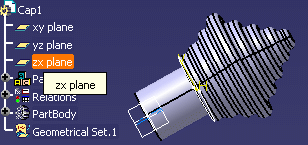![]()
- Knowledgeware parameters that are valuated by a formula are now taken
into account by the constraints satisfaction function. For a formula to
be taken into account:
- Access the Formula Editor and write a knowledge formula: Volume.1 = smartVolume( Pad.1) for example.
- Open the Constraint Satisfaction Editor and enter the
following constraint formula:
Volume.1 == 1L;
Pad.1\Height > 0mm;
Pad.1\Height < 10000mm
- It is possible to find more than one solution to a single problem (See Step 9).
-
Open the KwoCap.CATPart File. The following image is displayed.

-
Create a parameter that will compute the cap volume.
- Click the Formula icon (
 ).
).
- In the scrolling list, select the Volume parameter and click New Parameter of type.
- In the Edit name or value of the current parameter field, edit the name of the volume parameter: Cap_Volume in this scenario.
- Click Add Formula and enter the following formula:
Cap_Volume = Volume_Pad1 + Volume_Pad2 + Volume_Pad3 + Volume_Pad4 + Volume_Pad5 + Volume_Pad6 + Volume_Pad7 + Volume_Pad8 + Volume_Pad9
- Click OK twice to validate.
- Click the Formula icon (
-
From the Start > Knowledgeware menu, access the Product Engineering Optimizer workbench.
-
Click the Constraint Satisfaction icon (
 ).
Click OK in the opening window. The ConstraintSatisfaction.1
window opens.
).
Click OK in the opening window. The ConstraintSatisfaction.1
window opens. -
Enter the following formula into the editor:
Cap_Volume == 0.2L;
PartBody\Pad.1\FirstLimit\Length > 2mm;
PartBody\Pad.1\FirstLimit\Length < 100mm;
PartBody\Pad.2\FirstLimit\Length > 2mm;
PartBody\Pad.2\FirstLimit\Length < 50mm
-
Click the Parse arrow (
 ).
For more information about the interface, see
Getting Familiar with the Constraints
Satisfaction Editor.
).
For more information about the interface, see
Getting Familiar with the Constraints
Satisfaction Editor. -
Click the Results tab. In the Number of solutions to be found field, enter 4.
-
Click Solve. Click OK in the Solving was successful dialog box.
-
In the lower part of the editor, select line 3 and click Apply solution. The solution is applied to the parameters.
-
Click Apply: The model is updated. Click OK to exit the Constraint Satisfaction editor. Click No when prompted to save the log.